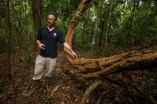(Press-News.org) MISSOULA – A new article by researchers from the University of Montana, the U.S. Geological Survey and Montana Fish, Wildlife & Parks asserts that climate warming is increasing the hybridization of trout – interbreeding between native and non-native species – in the interior western United States.
Clint Muhlfeld, a research assistant professor in the UM Division of Biological Sciences' Flathead Lake Biological Station and research ecologist with the USGS Northern Rocky Mountain Science Center in Glacier National Park, is the lead author of the article, titled "Invasive hybridization in a threatened species is accelerated by climate change," which was published in the latest issue of Nature Climate Change. Co-authors are Ryan Kovach, a postdoctoral scholar at UM's Flathead Lake Biological Station, and Leslie Jones, a UM doctoral student who works with Muhlfeld and USGS.
Specifically, rapid increases in stream temperature and decreases in spring flow over the past several decades contributed to the spread of hybridization between native westslope cutthroat trout and the introduced rainbow trout – the world's most widely introduced invasive fish – across the Flathead River system in Montana and British Columbia, Canada.
Experts have hypothesized that climate change could decrease worldwide biodiversity through cross-breeding between invasive and native species, but this study is the first to directly and scientifically support this prediction. The study was based on 30 years of research by scientists with UM, USGS and Montana FWP.
Hybridization has contributed to the decline and extinction of many native fishes worldwide, including all subspecies of cutthroat trout in western North America, which have enormous ecological and socioeconomic value. The researchers used long-term genetic monitoring data coupled with high-resolution climate and stream temperature predictions to measure whether climate warming enhances interactions between native and non-native species through hybridization.
"Climatic changes are threatening highly prized native trout as introduced rainbow trout continue to expand their range and hybridize with native populations through climate-induced 'windows of opportunity,' putting many populations and species at greater risk than previously thought," Muhlfeld said.
"The study illustrates that protecting genetic integrity and diversity of native species will be incredibly challenging when species are threatened with climate-induced invasive hybridization," he said.
Westslope cutthroat trout and rainbow trout both spawn in the spring and can produce fertile offspring when they interbreed. Over time, a mating population of native and non-native fish will result in only hybrid individuals with substantially reduced fitness because their genomes have been altered by non-native genes that are maladapted to the local environment. Protecting and maintaining the genetic integrity of native species is important for a species' ability to be resilient and better adapt to a rapidly changing climate.
Historical genetic samples revealed that hybridization between the two species was largely confined to one downstream Flathead River population. However, the study noted, during the past 30 years, hybridization rapidly spread upstream, irreversibly reducing the genetic integrity of native westslope cutthroat trout populations. Genetically pure populations of westslope cutthroat trout are known to occupy less than 10 percent of their historical range.
The rapid increase in hybridization was associated with climatic changes in the region. From 1978 to 2008, the rate of warming nearly tripled in the Flathead basin, resulting in earlier spring runoff, lower spring flooding and flows, and warming summer stream temperatures. Those locations with the greatest changes in stream flow and temperature experienced the greatest increases in hybridization.
Relative to cutthroat trout, rainbow trout prefer these climate-induced changes and tolerate greater environmental disturbance. These conditions likely have enhanced rainbow trout spawning and population numbers, leading to massive expansion of hybridization with westslope cutthroat trout.
"The evolutionary consequences of climate change are one of our greatest areas of uncertainty because empirical data addressing this issue are extraordinarily rare," Kovach said. "This study is a tremendous step forward in our understanding of how climate change can influence evolutionary process and ultimately species biodiversity."
Overall, aquatic ecosystems in western North America are predicted to experience earlier snowmelt in the spring, reduced late spring and summer flows, warmer and drier summers, and increased water temperatures – all of which indicate increased hybridization between these species.
INFORMATION:
Additional UM-affiliated authors are UM Wildlife Biology Program Director Winsor Lowe, UM Associate Professor of Conservation Ecology Gordon Luikart and Regents Professor Emeritus Fred Allendorf. Authors not affiliated with UM are Robert Al-Chokhachy with the USGS Northern Rocky Mountain Science Center, Matthew Boyer with Montana FWP in Kalispell and Robb Leary with Montana FWP in Missoula.
The study was supported by the Great Northern Landscape Conservation Cooperative, the U.S. Department of the Interior's Northwest Climate Science Center, the National Climate Change and Wildlife Science Center, the National Science Foundation and Bonneville Power Administration.
The article can be viewed online at http://dx.doi.org/10.1038/nclimate2252. For more information call Muhlfeld at 406-600-9686 or email cmuhlfeld@usgs.gov.
Study finds climate change accelerates hybridization between native, invasive trout
2014-05-27
ELSE PRESS RELEASES FROM THIS DATE:
Spontaneous thoughts are perceived to reveal meaningful self-insight
2014-05-27
PITTSBURGH—Spontaneous thoughts, intuitions, dreams and quick impressions. We all have these seemingly random thoughts popping into our minds on a daily basis. The question is what do we make of these unplanned, spur-of-the-moment thoughts? Do we view them as coincidental wanderings of a restless mind, or as revealing meaningful insight into ourselves?
A research team from Carnegie Mellon University and Harvard Business School set out to determine how people perceive their own spontaneous thoughts and if those thoughts or intuitions have any influence over judgment. ...
A habitable environment on Martian volcano?
2014-05-27
PROVIDENCE, R.I. [Brown University] — The slopes of a giant Martian volcano, once covered in glacial ice, may have been home to one of the most recent habitable environments yet found on the Red Planet, according to new research led by Brown University geologists.
Nearly twice as tall as Mount Everest, Arsia Mons is the third tallest volcano on Mars and one of the largest mountains in the solar system. This new analysis of the landforms surrounding Arsia Mons shows that eruptions along the volcano's northwest flank happened at the same time that a glacier covered the ...
Learning early in life may help keep brain cells alive
2014-05-27
Using your brain – particularly during adolescence – may help brain cells survive and could impact how it functions after puberty.
According to a recently published study in Frontiers in Neuroscience, Rutgers University behavioral neuroscientist Tracey Shors, who co-authored the study, found that the newborn brain cells in young rats that were successful at learning survived while the same brain cells in animals that didn't master the task died quickly.
"In those that didn't learn, three weeks after the new brain cells were made, one-half of them were no longer there," ...
Vanderbilt study finds women referred for bladder cancer less often than men
2014-05-27
Women with blood in their urine (hematuria) were less than half as likely as men with the same issue to be referred to a urologist for further tests, according to a new Vanderbilt University study.
The findings may help explain why women with bladder cancer are often diagnosed at a later stage in the disease and have worse mortality than men.
The study, presented by Jeffrey Bassett, M.D., MPH, fellow in Urologic Oncology, and Principal Investigator Daniel Barocas, M.D., MPH, assistant professor of Urologic Surgery, was shared during the American Urological Association ...
Addressing the physician shortage: Recommendations for medical education reform
2014-05-27
Since it started more than 30 years ago, funding the graduate medical education (GME) system has not evolved even as there has been a revolution in GME. The United States contributes almost $10 billion a year from Medicare into funding the GME system. However this system fails to provide the workforce needed for the 21st century and lacks the necessary transparency and accountability.
With an aging population and millions of people newly registered for health insurance because of the Affordable Care Act, there is a pressing need to increase the number of primary care ...
Vines choke a forest's ability to capture carbon, Smithsonian scientists report
2014-05-27
Tropical forests are a sometimes-underappreciated asset in the battle against climate change. They cover seven percent of land surface yet hold more than 30 percent of Earth's terrestrial carbon. As abandoned agricultural land in the tropics is taken over by forests, scientists expect these new forests to mop up industrial quantities of atmospheric carbon. New research by Smithsonian scientists shows increasingly abundant vines could hamper this potential and may even cause tropical forests to lose carbon.
In the first study to experimentally demonstrate that competition ...
Where have all the craters gone?
2014-05-27
Boulder, Colo., USA – Impact craters reveal one of the most spectacular geologic process known to man. During the past 3.5 billion years, it is estimated that more than 80 bodies, larger than the dinosaur-killing asteroid that struck the Yucatan Peninsula 66 million years ago, have bombarded Earth. However, tectonic processes, weathering, and burial quickly obscure or destroy craters. For example, if Earth weren't so dynamic, its surface would be heavily cratered like the Moon or Mercury.
Work by B.C. Johnson and T.J. Bowling predicts that only about four of the craters ...
Cancer, bioelectrical signals and the microbiome connected
2014-05-27
MEDFORD/SOMERVILLE, Mass. (May 27, 2014) -- Developmental biologists at Tufts University, using a tadpole model, have shown that bioelectrical signals from distant cells control the incidence of tumors arising from cancer-causing genes and that this process is impacted by levels of a common fatty acid produced by bacteria found in the tadpole and also in humans.
"Genetic information is often not enough to determine whether a cell will become cancerous; you also have to take into account the physiology of the cell and the bioelectrical signals it receives from other ...
Moderate-intensity physical activity program for older adults reduces mobility problems
2014-05-27
Among older adults at risk of disability, participation in a structured moderate-intensity physical activity program, compared with a health education intervention, significantly reduced the risk of major mobility disability (defined in this trial as loss of ability to walk 400 meters, or about a quarter mile), according to a study published by JAMA. The study is being released early online to coincide with its presentation at the American College of Sports Medicine annual meeting.
Mobility—the ability to walk without assistance—is a critical characteristic for functioning ...
Maintaining mobility in older adults can be as easy as a walk in the park
2014-05-27
With just a daily 20-minute walk, older adults can help stave off major disability and enhance the quality of their later years, according to results of the Lifestyle Interventions and Independence for Elders (LIFE) Study, conducted by researchers at Yale School of Medicine in collaboration with seven other institutions around the country. The study is published in the May 27 issue of the Journal of the American Medical Association.
Mobility, the ability to walk without assistance, is key to functioning independently. Reduced mobility is common in older adults and is ...


